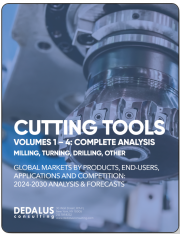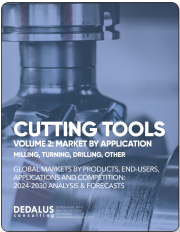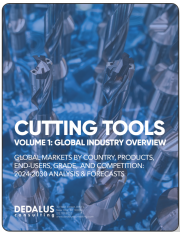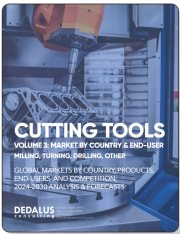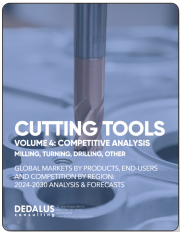
|
시장보고서
상품코드
1580959
세계의 기어 절단 도구 시장 : 제품, 재료, 용도, 최종 사용자별 예측(2025-2030년)Gear Cutting Tool Market by Product (Broaching Tools, Grinding Tools, Hobbing Tools), Material (Carbide, Cubic Boron Nitride, Diamond), Application, End-User - Global Forecast 2025-2030 |
||||||
기어 절단 도구 시장은 2023년에 1억 4,146만 달러로 평가되었고, 2024년에는 1억 4,761만 달러에 이를 것으로 예측되며, 복합 연간 성장률(CAGR) 4.38%로 성장하여 2030년에는 1억 9,101만 달러에 달할 것으로 예상됩니다.
기어 절단 도구는 제조, 특히 정밀한 기계 가공에 중점을 둔 산업에서 필수적인 부품입니다. 이 공구에는 기어 성형, 호브 절단 및 마무리에 사용되는 다양한 항목이 포함됩니다. 이러한 공구의 필요성은 자동차, 항공우주 및 산업 제조 부문에서 높은 정밀도와 효율성에 대한 수요가 증가함에 기인합니다. 그 용도는 기어의 절단이나 성형에 그치지 않고, 재생 가능 에너지나 수송용 기계 등 다양한 상황에서의 커스텀 솔루션의 제공에도 미치고 있습니다. 주요 최종 용도 시장은 자동차 제조 업체, 산업기계 제조 업체, 항공우주 기업입니다. 기어 절단 도구 시장은 제조 공정을 개선하는 자동화 및 IoT 통합과 같은 정확성과 효율성을 가능하게 하는 기술의 진보에 의해 견인되고 있습니다. 잠재적인 기회는 산업화가 가속화된 신흥 경제 국가에서 시장의 확대를 포함합니다. 이를 활용하기 위해 기업은 전략적 파트너십 형성과 현지 수요를 이해하기 위한 시장 조사 투자에 주력해야 합니다. 과제로는 초기 비용의 높이, 끊임없는 기술 혁신을 필요로 하는 공구 설계의 복잡성, 엄격한 환경 규제에 대한 대응 등이 있습니다. 또한 3D 프린팅과 같은 대체 기어 제조 기술과의 경쟁도 제한됩니다. 보다 수명이 길고 환경 친화적인 공구를 위한 재료 개발, 실시간 분석 및 유지보수 예측을 위한 스마트 기술 통합 등의 분야에서 기술 혁신이 필요합니다. 커스터마이징과 고객별 솔루션에 중점을 두면 성장으로 이어질 것입니다. 시장은 역동적이며 기업은 기술 혁신과 생산 공정의 효율화를 통해 경쟁 우위를 추구하고 있습니다. 지속적인 성장과 경쟁력을 확립하기 위해서는 진화하는 표준과 기술에 적응하고 혁신하기 위한 연구개발에 대한 지속적인 투자가 필수적입니다.
| 주요 시장 통계 | |
|---|---|
| 기준년(2023) | 1억 4,146만 달러 |
| 예측년(2024) | 1억 4,761만 달러 |
| 예측년(2030) | 1억 9,101만 달러 |
| 복합 연간 성장률(CAGR)(%) | 4.38% |
시장 역학 : 급속히 진화하는 기어 절단 도구 시장의 주요 시장 인사이트 공개
기어 절단 도구 시장은 수요 및 공급의 역동적 인 상호 작용에 의해 변모하고 있습니다. 이러한 시장 역학의 진화를 이해함으로써 기업은 충분한 정보를 바탕으로 투자결정, 전략적 의사결정, 새로운 비즈니스 기회를 획득할 수 있습니다. 이러한 동향을 종합적으로 파악함으로써 기업은 정치적, 지리적, 기술적, 사회적, 경제적 영역에 걸친 다양한 리스크를 경감할 수 있을 뿐만 아니라, 소비자 행동과 그것이 제조 비용 또는 구매 동향에 미치는 영향을보다 명확하게 이해할 수 있습니다.
- 시장 성장 촉진요인
- 세계의 제조업으로 자동화의 도입이 증가
- 자동차 생산 확대와 신뢰성이 높은 변속기 시스템의 필요성
- 에너지 분야의 확대와 재생 가능 에너지 시스템용 고정밀 기어에 대한 수요
- 시장 성장 억제요인
- 원하는 정밀도를 달성하기 위한 복잡성
- 시장 기회
- 기어 절단 도구의 성능과 정밀도를 향상시키기 위한 지속적인 진보
- 환경 친화적이고 지속 가능한 기어 절단 도구의 우선 순위 지정
- 시장의 과제
- 빈번한 유지보수의 필요성과 마모나 손상의 가능성
Porter's Five Forces : 기어 절단 도구 시장을 탐색하는 전략 도구
Porter's Five Forces Framework는 시장 상황경쟁 구도를 이해하는 중요한 도구입니다. Porter's Five Forces Framework는 기업의 경쟁력을 평가하고 전략적 기회를 탐구하는 명확한 기술을 제공합니다. 이 프레임워크는 기업이 시장 내 세력도를 평가하고 신규 사업의 수익성을 결정하는 데 도움이 됩니다. 이러한 인사이트을 통해 기업은 자사의 강점을 활용하고, 약점을 해결하고, 잠재적인 과제를 피할 수 있으며, 보다 강인한 시장에서의 포지셔닝을 보장할 수 있습니다.
PESTLE 분석 : 기어 절단 도구 시장에서 외부 영향을 파악
외부 거시 환경 요인은 치아 절삭 공구 시장의 성과 역학을 형성하는 데 매우 중요한 역할을합니다. 정치적, 경제적, 사회적, 기술적, 법적, 환경적 요인 분석은 이러한 영향을 탐색하는 데 필요한 정보를 제공합니다. PESTLE 요인을 조사함으로써 기업은 잠재적인 위험과 기회를 더 잘 이해할 수 있습니다. 이 분석을 통해 기업은 규제, 소비자 선호, 경제 동향의 변화를 예측하고 앞으로 예상되는 적극적인 의사 결정을 할 준비를 할 수 있습니다.
시장 점유율 분석 기어 절단 도구 시장 경쟁 구도 파악
기어 절단 도구 시장의 상세한 시장 점유율 분석을 통해 공급업체의 성과를 종합적으로 평가할 수 있습니다. 기업은 수익, 고객 기반, 성장률 등 주요 지표를 비교하여 경쟁 포지셔닝을 밝힐 수 있습니다. 이 분석을 통해 시장 집중, 단편화, 통합 동향을 밝혀내고 벤더들은 경쟁이 치열해지는 가운데 자사의 지위를 높이는 전략적 의사 결정을 내리는 데 필요한 지식을 얻을 수 있습니다.
FPNV 포지셔닝 매트릭스 기어 절단 도구 시장에서 공급업체의 성능 평가
FPNV 포지셔닝 매트릭스는 치아 공구 시장에서 공급업체를 평가하는 중요한 도구입니다. 이 행렬을 통해 비즈니스 조직은 공급업체의 비즈니스 전략과 제품 만족도를 기준으로 평가하여 목표에 맞는 충분한 정보를 바탕으로 의사 결정을 내릴 수 있습니다. 네 가지 사분면을 통해 공급업체를 명확하고 정확하게 세분화하여 전략 목표에 가장 적합한 파트너 및 솔루션을 파악할 수 있습니다.
전략 분석 및 추천 기어 절단 도구 시장에서 성공에 대한 길을 그립니다.
치아 절삭 공구 시장의 전략 분석은 시장에서의 존재를 강화하려는 기업에 필수적입니다. 주요 자원, 역량 및 성과 지표를 검토함으로써 기업은 성장 기회를 파악하고 개선을 위해 노력할 수 있습니다. 이러한 접근 방식을 통해 경쟁 구도에서 과제를 극복하고 새로운 비즈니스 기회를 활용하여 장기적인 성공을 거둘 수 있는 체제를 구축할 수 있습니다.
이 보고서는 주요 관심 분야를 포괄하는 시장의 종합적인 분석을 제공합니다.
1. 시장 침투 : 현재 시장 환경의 상세한 검토, 주요 기업의 광범위한 데이터, 시장 도달범위 및 전반적인 영향력 평가.
2. 시장 개척도 : 신흥 시장의 성장 기회를 파악하고 기존 분야의 확장 가능성을 평가하며 미래 성장을 위한 전략적 로드맵을 제공합니다.
3. 시장 다양화 : 최근 제품 출시, 미개척 지역, 업계의 주요 진보, 시장을 형성하는 전략적 투자를 분석합니다.
4. 경쟁 평가 및 정보 : 경쟁 구도를 철저히 분석하여 시장 점유율, 사업 전략, 제품 포트폴리오, 인증, 규제 당국 승인, 특허 동향, 주요 기업의 기술 진보 등을 검증합니다.
5. 제품 개발 및 혁신 : 미래 시장 성장을 가속할 것으로 예상되는 최첨단 기술, R&D 활동, 제품 혁신을 강조합니다.
또한 이해관계자가 충분한 정보를 얻고 의사결정을 할 수 있도록 중요한 질문에 대답하고 있습니다.
1. 현재 시장 규모와 향후 성장 예측은?
2. 최고의 투자 기회를 제공하는 제품, 부문 및 지역은 어디입니까?
3. 시장을 형성하는 주요 기술 동향과 규제의 영향은?
4. 주요 벤더의 시장 점유율과 경쟁 포지션은?
5. 벤더 시장 진입, 철수 전략의 원동력이 되는 수익원과 전략적 기회는 무엇인가?
목차
제1장 서문
제2장 조사 방법
제3장 주요 요약
제4장 시장 개요
제5장 시장 인사이트
- 시장 역학
- 성장 촉진요인
- 세계의 제조업에 있어서의 자동화의 도입이 증가
- 자동차 생산 증가와 신뢰성이 높은 변속기 시스템의 필요성
- 에너지 분야의 확대와 재생 가능 에너지 시스템용 고정밀 기어 수요
- 억제요인
- 원하는 정밀도와 정밀도를 달성하는 복잡성
- 기회
- 기어 절삭 공구의 성능과 정밀도를 향상시키기 위한 지속적인 진보
- 환경 친화적이고 지속 가능한 기어 절삭 공구 우선
- 과제
- 자주 유지 보수가 필요하고 마모의 가능성이 있습니다
- 성장 촉진요인
- 시장 세분화 분석
- 제품 : 호빙 공구는 효율성, 다재다능성 및 다양한 유형의 기어를 생산할 수 있다는 장점으로 채택이 진행되고 있습니다.
- 용도 : 세계 자동차 수요 증가에 대응하기 위해 자동차 산업이 세계적으로 확대
- Porter's Five Forces 분석
- PESTEL 분석
- 정치적
- 경제
- 사교
- 기술적
- 법률상
- 환경
제6장 기어 절단 도구 시장 : 제품별
- 브로칭 툴
- 연삭 공구
- 호브 공구
- 밀링 가공 공구
- 쉐이핑 툴
제7장 기어 절단 도구 시장 : 소재별
- 탄화물
- 입방정 질화붕소
- 다이아몬드
- 하이스강
제8장 기어 절단 도구 시장 : 용도별
- 항공우주
- 자동차
- 산업기계
- 풍력
제9장 기어 절단 도구 시장 : 최종 사용자별
- 애프터마켓
- 제조 유닛
- 오리지널 기기 제조업체
제10장 아메리카의 기어 절단 도구 시장
- 아르헨티나
- 브라질
- 캐나다
- 멕시코
- 미국
제11장 아시아태평양의 기어 절단 도구 시장
- 호주
- 중국
- 인도
- 인도네시아
- 일본
- 말레이시아
- 필리핀
- 싱가포르
- 한국
- 대만
- 태국
- 베트남
제12장 유럽, 중동 및 아프리카의 기어 절단 도구 시장
- 덴마크
- 이집트
- 핀란드
- 프랑스
- 독일
- 이스라엘
- 이탈리아
- 네덜란드
- 나이지리아
- 노르웨이
- 폴란드
- 카타르
- 러시아
- 사우디아라비아
- 남아프리카
- 스페인
- 스웨덴
- 스위스
- 터키
- 아랍에미리트(UAE)
- 영국
제13장 경쟁 구도
- 시장 점유율 분석(2023년)
- FPNV 포지셔닝 매트릭스(2023년)
- 경쟁 시나리오 분석
- Nidec Group의 공작기계 4사가 CCMT2024에 출전하여 다양한 산업 요구에 부응하는 솔루션을 제공
- ANCA와 esco가 고도의 기어 절단 도구 솔루션으로 협력
- Star SU, 루이 베레 제품의 북미 총대리점으로 선정
- 전략 분석과 제안
기업 목록
- Bourn & Koch
- Burri Werkzeugmaschinen GmbH & Co. KG
- DIC Tools
- DMG MORI CO., LTD.
- EMAG GmbH & Co. KG
- ESGI Tools Private Limited
- Gleason Corporation
- Helios Gear Product
- KAPP NILES GmbH & Co. KG
- Kennametal Inc.
- Klingelnberg GmbH
- Liebherr Group
- LMT Tools GmbH & Co. KG
- Mazak Corporation
- Mitsubishi Heavy Industries, Ltd.
- Nachi-Fujikoshi Corp.
- Reishauer AG
- SS Tools.
- Sandvik Coromant
- Seco Tools AB
- Star SU LLC
- Super Hobs & Broaches Pvt. Ltd.
- SUPER TOOLS CORPORATION
- TPR OSAKA SEIMITSU KIKAI CO., LTD.
- YG-1 Co., Ltd.
The Gear Cutting Tool Market was valued at USD 141.46 million in 2023, expected to reach USD 147.61 million in 2024, and is projected to grow at a CAGR of 4.38%, to USD 191.01 million by 2030.
Gear cutting tools are essential components in the manufacturing sector, specifically within industries focusing on precise mechanical processes. They encompass a range of items used for gear shaping, hobbing, and finishing. The necessity of these tools stems from the increasing demand for high precision and efficiency in automotive, aerospace, and industrial manufacturing sectors. Their applications extend beyond cutting and shaping gears to include the provision of custom solutions in diverse contexts, such as in machinery for renewable energy and transportation. The primary end-use markets are automotive manufacturers, industrial machinery producers, and aerospace companies. The market for gear cutting tools is driven by technological advancements that enable precision and efficiency, like automation and IoT integration, which improve manufacturing processes. Potential opportunities include expanding markets in developing economies where industrialization is accelerating. To capitalize on these, businesses should focus on forming strategic partnerships and investing in market research to understand local demands. Challenges include high initial costs, the complexity of tool designs requiring constant innovation, and the demand to meet stringent environmental regulations. Additionally, competition from alternative gear manufacturing techniques like 3D printing poses a limitation. Innovation is necessary in areas such as material development for longer-lasting and environmentally friendly tools and the integration of smart technologies for real-time analytics and maintenance prediction. A focus on customization and client-specific solutions will likely lead to growth. The market is dynamic, with firms striving for competitive advantage through technological innovation and efficiency in production processes. Continued investment in research and development to adapt and innovate amidst evolving standards and technologies will be crucial for sustained growth and competitive positioning.
| KEY MARKET STATISTICS | |
|---|---|
| Base Year [2023] | USD 141.46 million |
| Estimated Year [2024] | USD 147.61 million |
| Forecast Year [2030] | USD 191.01 million |
| CAGR (%) | 4.38% |
Market Dynamics: Unveiling Key Market Insights in the Rapidly Evolving Gear Cutting Tool Market
The Gear Cutting Tool Market is undergoing transformative changes driven by a dynamic interplay of supply and demand factors. Understanding these evolving market dynamics prepares business organizations to make informed investment decisions, refine strategic decisions, and seize new opportunities. By gaining a comprehensive view of these trends, business organizations can mitigate various risks across political, geographic, technical, social, and economic domains while also gaining a clearer understanding of consumer behavior and its impact on manufacturing costs and purchasing trends.
- Market Drivers
- Increasing adoption of automation in manufacturing industries across the world
- Growing automotive production and the need for reliable transmission systems
- Expansion in the energy sector and demand for high-precision gears for renewable energy systems
- Market Restraints
- Complexities in achieving the desired accuracy and precision
- Market Opportunities
- Ongoing advancements to improve the performance and accuracy of gear cutting tools
- Prioritization of eco-friendly, sustainable gear cutting tools
- Market Challenges
- Frequent need for maintenance and possibility of wear and tear
Porter's Five Forces: A Strategic Tool for Navigating the Gear Cutting Tool Market
Porter's five forces framework is a critical tool for understanding the competitive landscape of the Gear Cutting Tool Market. It offers business organizations with a clear methodology for evaluating their competitive positioning and exploring strategic opportunities. This framework helps businesses assess the power dynamics within the market and determine the profitability of new ventures. With these insights, business organizations can leverage their strengths, address weaknesses, and avoid potential challenges, ensuring a more resilient market positioning.
PESTLE Analysis: Navigating External Influences in the Gear Cutting Tool Market
External macro-environmental factors play a pivotal role in shaping the performance dynamics of the Gear Cutting Tool Market. Political, Economic, Social, Technological, Legal, and Environmental factors analysis provides the necessary information to navigate these influences. By examining PESTLE factors, businesses can better understand potential risks and opportunities. This analysis enables business organizations to anticipate changes in regulations, consumer preferences, and economic trends, ensuring they are prepared to make proactive, forward-thinking decisions.
Market Share Analysis: Understanding the Competitive Landscape in the Gear Cutting Tool Market
A detailed market share analysis in the Gear Cutting Tool Market provides a comprehensive assessment of vendors' performance. Companies can identify their competitive positioning by comparing key metrics, including revenue, customer base, and growth rates. This analysis highlights market concentration, fragmentation, and trends in consolidation, offering vendors the insights required to make strategic decisions that enhance their position in an increasingly competitive landscape.
FPNV Positioning Matrix: Evaluating Vendors' Performance in the Gear Cutting Tool Market
The Forefront, Pathfinder, Niche, Vital (FPNV) Positioning Matrix is a critical tool for evaluating vendors within the Gear Cutting Tool Market. This matrix enables business organizations to make well-informed decisions that align with their goals by assessing vendors based on their business strategy and product satisfaction. The four quadrants provide a clear and precise segmentation of vendors, helping users identify the right partners and solutions that best fit their strategic objectives.
Strategy Analysis & Recommendation: Charting a Path to Success in the Gear Cutting Tool Market
A strategic analysis of the Gear Cutting Tool Market is essential for businesses looking to strengthen their global market presence. By reviewing key resources, capabilities, and performance indicators, business organizations can identify growth opportunities and work toward improvement. This approach helps businesses navigate challenges in the competitive landscape and ensures they are well-positioned to capitalize on newer opportunities and drive long-term success.
Key Company Profiles
The report delves into recent significant developments in the Gear Cutting Tool Market, highlighting leading vendors and their innovative profiles. These include Bourn & Koch, Burri Werkzeugmaschinen GmbH & Co. KG, DIC Tools, DMG MORI CO., LTD., EMAG GmbH & Co. KG, ESGI Tools Private Limited, Gleason Corporation, Helios Gear Product, KAPP NILES GmbH & Co. KG, Kennametal Inc., Klingelnberg GmbH, Liebherr Group, LMT Tools GmbH & Co. KG, Mazak Corporation, Mitsubishi Heavy Industries, Ltd., Nachi-Fujikoshi Corp., Reishauer AG, S.S. Tools., Sandvik Coromant, Seco Tools AB, Star SU LLC, Super Hobs & Broaches Pvt. Ltd., SUPER TOOLS CORPORATION, TPR OSAKA SEIMITSU KIKAI CO., LTD., and YG-1 Co., Ltd..
Market Segmentation & Coverage
This research report categorizes the Gear Cutting Tool Market to forecast the revenues and analyze trends in each of the following sub-markets:
- Based on Product, market is studied across Broaching Tools, Grinding Tools, Hobbing Tools, Milling Tools, and Shaping Tools.
- Based on Material, market is studied across Carbide, Cubic Boron Nitride, Diamond, and High-Speed Steel.
- Based on Application, market is studied across Aerospace, Automotive, Industrial Machinery, and Wind Power.
- Based on End-User, market is studied across Aftermarket, Manufacturing Units, and Original Equipment Manufacturers.
- Based on Region, market is studied across Americas, Asia-Pacific, and Europe, Middle East & Africa. The Americas is further studied across Argentina, Brazil, Canada, Mexico, and United States. The United States is further studied across California, Florida, Illinois, New York, Ohio, Pennsylvania, and Texas. The Asia-Pacific is further studied across Australia, China, India, Indonesia, Japan, Malaysia, Philippines, Singapore, South Korea, Taiwan, Thailand, and Vietnam. The Europe, Middle East & Africa is further studied across Denmark, Egypt, Finland, France, Germany, Israel, Italy, Netherlands, Nigeria, Norway, Poland, Qatar, Russia, Saudi Arabia, South Africa, Spain, Sweden, Switzerland, Turkey, United Arab Emirates, and United Kingdom.
The report offers a comprehensive analysis of the market, covering key focus areas:
1. Market Penetration: A detailed review of the current market environment, including extensive data from top industry players, evaluating their market reach and overall influence.
2. Market Development: Identifies growth opportunities in emerging markets and assesses expansion potential in established sectors, providing a strategic roadmap for future growth.
3. Market Diversification: Analyzes recent product launches, untapped geographic regions, major industry advancements, and strategic investments reshaping the market.
4. Competitive Assessment & Intelligence: Provides a thorough analysis of the competitive landscape, examining market share, business strategies, product portfolios, certifications, regulatory approvals, patent trends, and technological advancements of key players.
5. Product Development & Innovation: Highlights cutting-edge technologies, R&D activities, and product innovations expected to drive future market growth.
The report also answers critical questions to aid stakeholders in making informed decisions:
1. What is the current market size, and what is the forecasted growth?
2. Which products, segments, and regions offer the best investment opportunities?
3. What are the key technology trends and regulatory influences shaping the market?
4. How do leading vendors rank in terms of market share and competitive positioning?
5. What revenue sources and strategic opportunities drive vendors' market entry or exit strategies?
Table of Contents
1. Preface
- 1.1. Objectives of the Study
- 1.2. Market Segmentation & Coverage
- 1.3. Years Considered for the Study
- 1.4. Currency & Pricing
- 1.5. Language
- 1.6. Stakeholders
2. Research Methodology
- 2.1. Define: Research Objective
- 2.2. Determine: Research Design
- 2.3. Prepare: Research Instrument
- 2.4. Collect: Data Source
- 2.5. Analyze: Data Interpretation
- 2.6. Formulate: Data Verification
- 2.7. Publish: Research Report
- 2.8. Repeat: Report Update
3. Executive Summary
4. Market Overview
5. Market Insights
- 5.1. Market Dynamics
- 5.1.1. Drivers
- 5.1.1.1. Increasing adoption of automation in manufacturing industries across the world
- 5.1.1.2. Growing automotive production and the need for reliable transmission systems
- 5.1.1.3. Expansion in the energy sector and demand for high-precision gears for renewable energy systems
- 5.1.2. Restraints
- 5.1.2.1. Complexities in achieving the desired accuracy and precision
- 5.1.3. Opportunities
- 5.1.3.1. Ongoing advancements to improve the performance and accuracy of gear cutting tools
- 5.1.3.2. Prioritization of eco-friendly, sustainable gear cutting tools
- 5.1.4. Challenges
- 5.1.4.1. Frequent need for maintenance and possibility of wear and tear
- 5.1.1. Drivers
- 5.2. Market Segmentation Analysis
- 5.2.1. Product: Emerging adoption of hobbing tools owing to their efficiency, versatility, and ability to produce a wide range of gear types
- 5.2.2. Application: Expansion of the automotive industry worldwide to cater to the global increase in demand for vehicles
- 5.3. Porter's Five Forces Analysis
- 5.3.1. Threat of New Entrants
- 5.3.2. Threat of Substitutes
- 5.3.3. Bargaining Power of Customers
- 5.3.4. Bargaining Power of Suppliers
- 5.3.5. Industry Rivalry
- 5.4. PESTLE Analysis
- 5.4.1. Political
- 5.4.2. Economic
- 5.4.3. Social
- 5.4.4. Technological
- 5.4.5. Legal
- 5.4.6. Environmental
6. Gear Cutting Tool Market, by Product
- 6.1. Introduction
- 6.2. Broaching Tools
- 6.3. Grinding Tools
- 6.4. Hobbing Tools
- 6.5. Milling Tools
- 6.6. Shaping Tools
7. Gear Cutting Tool Market, by Material
- 7.1. Introduction
- 7.2. Carbide
- 7.3. Cubic Boron Nitride
- 7.4. Diamond
- 7.5. High-Speed Steel
8. Gear Cutting Tool Market, by Application
- 8.1. Introduction
- 8.2. Aerospace
- 8.3. Automotive
- 8.4. Industrial Machinery
- 8.5. Wind Power
9. Gear Cutting Tool Market, by End-User
- 9.1. Introduction
- 9.2. Aftermarket
- 9.3. Manufacturing Units
- 9.4. Original Equipment Manufacturers
10. Americas Gear Cutting Tool Market
- 10.1. Introduction
- 10.2. Argentina
- 10.3. Brazil
- 10.4. Canada
- 10.5. Mexico
- 10.6. United States
11. Asia-Pacific Gear Cutting Tool Market
- 11.1. Introduction
- 11.2. Australia
- 11.3. China
- 11.4. India
- 11.5. Indonesia
- 11.6. Japan
- 11.7. Malaysia
- 11.8. Philippines
- 11.9. Singapore
- 11.10. South Korea
- 11.11. Taiwan
- 11.12. Thailand
- 11.13. Vietnam
12. Europe, Middle East & Africa Gear Cutting Tool Market
- 12.1. Introduction
- 12.2. Denmark
- 12.3. Egypt
- 12.4. Finland
- 12.5. France
- 12.6. Germany
- 12.7. Israel
- 12.8. Italy
- 12.9. Netherlands
- 12.10. Nigeria
- 12.11. Norway
- 12.12. Poland
- 12.13. Qatar
- 12.14. Russia
- 12.15. Saudi Arabia
- 12.16. South Africa
- 12.17. Spain
- 12.18. Sweden
- 12.19. Switzerland
- 12.20. Turkey
- 12.21. United Arab Emirates
- 12.22. United Kingdom
13. Competitive Landscape
- 13.1. Market Share Analysis, 2023
- 13.2. FPNV Positioning Matrix, 2023
- 13.3. Competitive Scenario Analysis
- 13.3.1. The Nidec Group's Four Machine Tool Companies to Showcase Their Products at CCMT2024, Offering Solutions for Diverse Industrial Needs
- 13.3.2. ANCA and esco Collaborate on Advanced Gear Cutting Tool Solutions
- 13.3.3. Star SU Chosen as the Sole Distributor for Louis Belet Products in North America
- 13.4. Strategy Analysis & Recommendation
Companies Mentioned
- 1. Bourn & Koch
- 2. Burri Werkzeugmaschinen GmbH & Co. KG
- 3. DIC Tools
- 4. DMG MORI CO., LTD.
- 5. EMAG GmbH & Co. KG
- 6. ESGI Tools Private Limited
- 7. Gleason Corporation
- 8. Helios Gear Product
- 9. KAPP NILES GmbH & Co. KG
- 10. Kennametal Inc.
- 11. Klingelnberg GmbH
- 12. Liebherr Group
- 13. LMT Tools GmbH & Co. KG
- 14. Mazak Corporation
- 15. Mitsubishi Heavy Industries, Ltd.
- 16. Nachi-Fujikoshi Corp.
- 17. Reishauer AG
- 18. S.S. Tools.
- 19. Sandvik Coromant
- 20. Seco Tools AB
- 21. Star SU LLC
- 22. Super Hobs & Broaches Pvt. Ltd.
- 23. SUPER TOOLS CORPORATION
- 24. TPR OSAKA SEIMITSU KIKAI CO., LTD.
- 25. YG-1 Co., Ltd.







